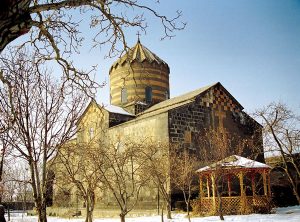St. Gevorg Monastery of Mughni

According to the historian Zakaria Sarkavag, St. Gevorg Monastery was founded in the 13th century by the brotherhood at Hovhannavank, bringing with them the relics of St. George. St. George was a 3th century Roman general who, under the reign of Diocletian, defied the Emperor’s policy of persecuting Christians by publicly tearing up the Emperor’s decree. He urged others to follow his example, disregarding those who could harm the body, but not the soul.
The monastery was completely rebuilt by the order of Hovhannes vardapet in 1661-1669 by the architect Sahak Hizanetsi and his student Murat. The domed-basilica architectural style of the church is accented by distinctive decorations of orange tuff stone. Especially striking is the black and orange striped dome. The murals in the interior of the church date to the 17th century and were probably the work of Naghash Hovnatan, whose paintings adorn a number of churches, including the Cathedral of Etchmiadzin.
At this monastery, Simeon the Elder copied an ornately decorated gospel in 1280, known today as the Mughni Gospel. Each year on September 18, the monastery holds a celebration, in connection with St. George’s Day, during which the Mughni Gospel is brought from the Matenadaran for a special divine liturgy.
Archbishop Mesrop Ashjian of blessed memory adopted this monastery and led the effort to renovate it. It was re-consecrated by Catholicos Karekin II in 2000.
Reflection
In our silent prayers, let us give thanks to God for protecting this monastery and giving our forefathers strength to persevere in their faith. Let us ask for the intercession of the fearless General St. Gevorg, and let us remember the builders of this monastery, Hovhannes vardapet, architect Sahak Hizanetsi and his student Murat, as well as the manuscript illuminator Simeon the Elder. Let us also remember Abp. Mesrop Ashjian, whose ministry brought him back to the homeland and brought this church back to life.
